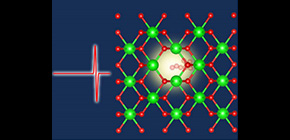
Microscopic motion of an ion just before hopping to an unoccupied site observed
Will help to evaluate ionic conductivity of solid electrolytes for the development of more sophisticated fuel cells
A group of researchers led by Associate Professor NAGAI Masaya from Osaka University, in cooperation with Associate Professor OKUYAMA Yuji from Miyazaki University, and Researcher KANI Yukimune from Panasonic Corporation, observed ion migration in solid electrolytes used for solid oxide fuel cells (SOFCs) by terahertz time-domain spectroscopy (THz-TDS), a world first.
The basic structure of a fuel cell, a pollution-free, highly efficient energy generator that converts chemical energy to electricity, consists of a solid electrolyte that allows only ions to pass through. To improve performance of SOFCs, chemically stable solid electrolytes with high ion conductivity are necessary.
The conductance of an electrolytic solution results from the movement of the ions it contains as they migrate toward the appropriate electrodes. The performance of a solid electrolyte system is strongly dependent on the nature and quality of the electrodes used for signal collection. High ionic conductivity of the solid electrolyte means high performance of fuel cells. Ion transport in solid electrolytes is decisive for the performance of fuel cells, and two electrodes are used to measure the electrical conductance of the fluid.
In the electrolyte of SOFCs, an ion, or a charge carrier, hops to an adjacent vacant site after numerous attempts in the span of one ten-trillionth of a second (1x10 -13 sec). When ion hopping occurs, the amplitude of attempt frequency becomes large and the attempt just before hopping slows down. This group thought that if this microscopic motion of the ion just before hopping to an unoccupied site is obtained by THz-TDS, they could obtain information about the conductive properties of solid electrolytes.
THz-TDS is a spectroscopic technique in which the properties of matter are probed with short pulses of terahertz radiation and the THz frequency band enables short-distance large-capacity wireless communications. Measuring with THz waves is used as non-contact, non-destructive technology.
Generally, the conductivity obtained from impedance measurements shows long-range ion transport, but is temperature dependent. However, because activation energy obtained by the THz conductivity measurements reflects only the intrinsic migration energy of the oxygen vacancy, the conductivity is not temperature dependent.
In verification experiments using THz-TDS, the researchers measured the conductivity and its temperature dependency in yttria-stabilized zirconia Zr 0.84 Y 0.16 O 2−δ (8YSZ), a widely used solid electrolyte material, to evaluate energy necessary for ion migration (activation energy). The low-frequency activation energy was obtained by impedance measurements, but, in measurements using THz waves, the THz activation energy decreased with the ionic radius of the dopant. The evaluated conductivity includes the information on the microscopic motion of the ion just before hopping to an unoccupied site occurs, which cannot easily be evaluated by conventional techniques.
Typically, the effective lattice constant increases with an increase of the dopant ionic radius, so the energy of the potential barrier at the Zr–Zr saddle point, or the energy required for the hopping to the next equivalent site, is reduced, making ionic migration easier. Thus, the group concluded that activation energy determined by the THz-TDS conductivity measurements reflected the intrinsic migration energy of the oxygen vacancy and that impedance measurements would not be able to obtain this information.
THz-TDS was found to be useful for evaluating properties of solid electrolytes, which are essential for fuel cells. Evaluation of solid electrolytes by THz-TDS can help to explore solid electrolytes that enhance the performance of fuel cells and all-solid-state batteries.
Figure 1
Figure 2
Figure 3
The article, "Microscopic ion migration in solid electrolytes revealed by terahertz-time-domain-spectroscopy" was published in the Nature Communications at DOI: https://doi.org/10.1038/s41467-019-10501-9 .
Related links

